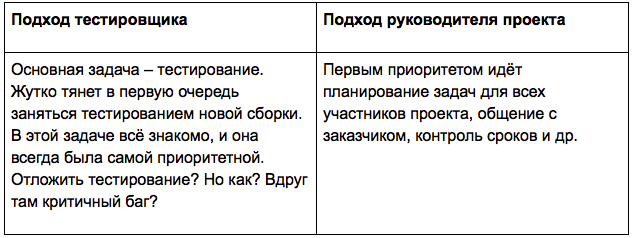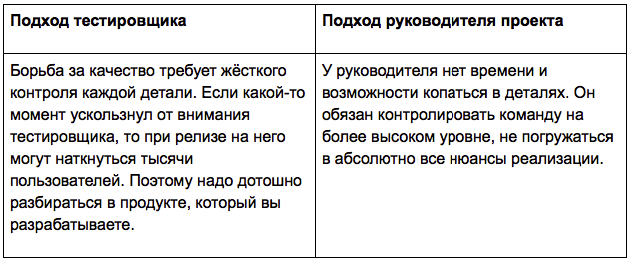Transition from tester to project managers

Usually, the position of project manager in an IT company requires people with experience from 1 year. Therefore, often inexperienced managers get a job as analysts, testers, sometimes even developers.
If you show yourself well, over time you will be trusted with more managerial tasks. It is not always possible to abandon the old duties. We have to combine two roles on the project. So I, having experience in testing and analytics, additionally began to receive tasks of the project manager. Over time, I completely transferred to project management.
In this article, I share observations and conclusions. How do testers' habits and project manager responsibilities conflict in one person? What problems do you have to face? What benefits can be derived from this transition? If you want to get answers to these questions, welcome under cat.
Problem 1. Prioritization
The bad news is: at the beginning of the transition, the old tasks have not gone away; there are also new responsibilities. There are many tasks, all of them are important. There was a great desire to clone themselves to perform them simultaneously.

Alas, but the management tasks are much more important than the tasks of the tester, if you have to combine. Now you are responsible for everyone in the team, and postponing management tasks is fraught with the downtime of others.
What to do? I was helped by drawing up a list of tasks, relying on the question: “If I postpone this task, how will this affect the project?” - and the observance of the received plan. Now the main thing is not the bugs, but the tasks, terms and budget of the project.
Problem 2. Lack of time
Many "turning into management" experts face this. There is no time left for full immersion in testing. Testing is either postponed to the last moment and slows down the development, or suffers from poor-quality performance. Both options are unacceptable.

What to do? Fix or develop a problem with facts. I was helped by the meticulous tracking of all completed tasks.
After analyzing the results, I identified two areas over which it was necessary to work.
The first direction: inefficient execution of a certain type of tasks.
For example, I had long negotiations with the customer and rallies prolonged in time.
In this case, you need to think how to optimize, experiment. Until you decide this moment, it makes no sense to ask for more people to help out on the project.
The second direction: tasks that are postponed each time as non-priority until they start to burn.
In particular, for me, the management tasks became bigger as the team grew. Test tasks were postponed until the last. Work began beyond the norm in order to do everything and everywhere. I was negatively affected by systematic processing. I was ineffective and there was not much enthusiasm.
The prioritization and time tracking helped. Do not be afraid to consult with management, whether you correctly assess the importance of the task. This is normal, as you still have little experience in management. So you show the problem from the inside.
If the authorities know how to listen and your arguments are adequate, they will find a specialist to help you. With regret I inform the obvious: there is a high probability that the tasks of the tester will be removed from you.
Problem 3. Attitude to fine details
By inertia, I was aware of everything on the project. On the one hand, understand everything well. On the other hand, information overload began, and there was a big risk of missing something important.

Before, I could tell by heart where the error might occur and how it was processed. Now, to find out just did not have enough time. And I reproached myself for not being aware of all the information on the project.
What to do? Understand that the details are now the responsibility of other team members. The task of the head is to know who can quickly get information if necessary.
Problem 4. Trust in the team

I understood that I could check better, find a bug faster. I had a constant temptation to double-check.
What to do? Exhale and give the team to independently engage in tasks and solve problems that arise, if there is still time. The task of the leader is to ensure the comfortable execution of the task to all team members. Do not interfere with their premature care.
I watched the project activities of the managers, who were lucky to immediately start their journey with management. They easily operate with abstractions, not trying to understand what is inside. But with the help of my testing skills, I rescued the team in crisis situations.
Problem 5. Team Responsibility

What to do? Take full responsibility for yourself. Do not blame someone specific. Learn to express reasonable discontent with the team when required. Transmit customer claims only in the form of tasks. Be able to protect the team. Try to understand the mood in the team.
I knew how to take responsibility for myself. It was more difficult to find the right words when problems arose. It is necessary to understand people well, so that with a careless word they will not be demotivated. This is not easy to do, because often project managers work with the people they have been assigned to the project. Each needs its own approach.
Someone from the team will probably be difficult to restructure on the fact that the tester has become a leader, and you need to report to him. Alas, only time will fix it. It will be necessary to prove to the team that you are able to make good management decisions and can control the process.
Problem 6. Internal perfectionism

It is necessary to say “stop” in time and weed out what can wait. This can be assessed only by the project manager, he is aware of the entire financial side and is responsible for compliance with the plans.
What to do? Now everything must be viewed through the prism of "time is money." It is important to release the release on time. Sometimes it is better to discuss the problem with the customer and jointly set priorities, rather than trying to fix everything.
This is a big gap between the project manager and the testing department. Testers discover the problem and feel happy that they have done their duty. The manager is afraid to detect the problem, as this will delay the deadline for completing the task.
Problem 7. Claims and pessimism

It is impossible to avoid all the problems. They arise both in the team and on the part of customers. When the team appeared dissatisfied, it quickly spread to others.
What to do? Do not panic, stop its groundless spread on the project. Focus on finding a solution. Quietly treat dissatisfaction and maintain sound sanity. Less emotion.
Discontent is normal, because everyone wants to improve the project. Only indifferent no complaints. We must learn to work with it.
My findings
In this list, I identified the problems that I faced myself during the transition from testing to management. Some of them managed to be overcome; according to others, awareness came only after observing more experienced colleagues.
As a project manager, I had to learn to live with the following features:
- Few research tasks. Acquired technical skills are forgotten and become obsolete as unnecessary.
- The inability to recruit your team. Most often, project managers work with those they have been assigned to the project.
- Go to another project - difficult. Do not like the project? So you are doing something wrong.
- There is no independence from the mandatory reading of instant messengers / letters 24/7. A huge number of communications, phoning, meetings and letters.
- It is difficult to isolate from sudden important tasks that require immediate switching.
- You need to have nerves of steel to skillfully filter the flow of problems coming from different sides.
Useful skills that have been acquired:
- The ability to find a common language with all team members and customers.
- The ability to solve problems on the project and predict them.
- Understanding and acceptance of the reasons for management decisions.
- Awareness of how the overall project development process is built.
But all this is only personal experience and observation. Do not be afraid to try new things.
')
Source: https://habr.com/ru/post/344266/
All Articles